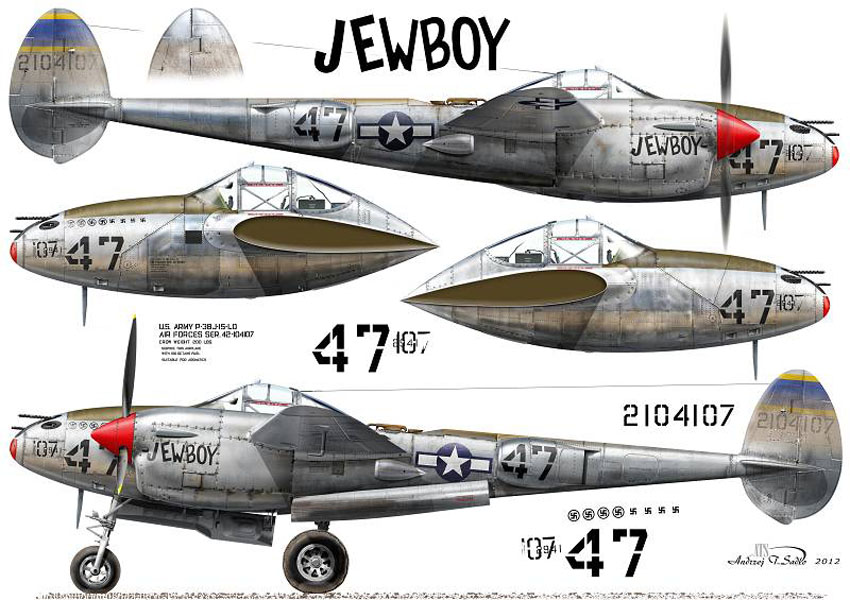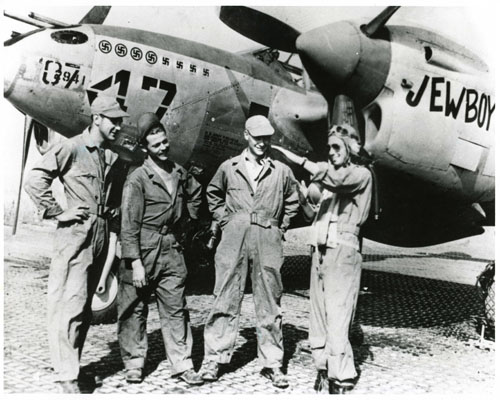Doubtless some visitors to this blog will already be familiar with Lockheed’s P-38 Lightning, but for those who are not… The Lightning was one of most versatile, successful, and particularly one of the most physically distinctive fighter aircraft of the Second World War. Designed by the Lockheed corporation to meet a 1936 Army Air Force Request for Proposals (RFP) for a new fighter (“interceptor”) aircraft capable of protecting the continental United States from bomber aircraft, in time the P-38 would also successfully fulfill the roles of aerial reconnaissance, pathfinder, bombardment leader (“droop-snoot”), and night fighter (albeit not actually used in combat in that role).
Particularly and immediately noticeable is the aircraft’s general design: The configuration of most fighter aircraft of the Second World War – whether powered by radial or in-line (liquid-cooled) engines – was manifested in the “conventional” planform of a fuselage with engine at front, atop low-mounted wings, and with a single tail. Of course, tremendous variation in design existed between the Axis and Allies, let alone among the aircraft manufacturers of any warring nation. Due to the RFP requirements for speed, a fast rate of climb, heavy firepower, and duration of flight at full throttle, the Lightning was strikingly different. This was due to the innovative approach of the aircraft’s design team, which was headed by Clarence C. “Kelly” Johnson.
Two supercharged engines were used. But, rather than a conventional, continuous fuselage extending to and terminating in a single tail unit, the pilot and armament (and other equipment, such as aerial cameras, bombsight, or bombing radar), and radio were situated in a central “pod” or “gondola” between the engines, the latter being housed in individual nacelles, each extending rearward to an individual fin and rudder. Mounted between and “connecting” these twin fins and rudders was a horizontal stabilizer / elevator, with the plane resting on tricycle landing gear. The resulting design was visually distinctive and thus readily identifiable at great distances, by coincidence imparting an almost “art-deco” quality to the plane.
Though other WW II American military aircraft may be better known in popular culture, the Lighting’s technologically innovative design and consequent versatility, combined with its performance and firepower, eventuated in an outstanding and eminently successful military aircraft.
And in another sense, an aesthetically beautiful flying machine, as well.
The Lightning was used by the Army Air Force in all combat theaters, rising to special preeminence in the Pacific, the United States’ two most successful WW II aces (Major Richard I. Bong and Major Thomas B. McGuire, Jr.) attaining the entirety of their victories against the against the Japanese in P-38s. In the European Theater, though eventually almost entirely superseded – in the fighter role – in the 8th and 9th Air Forces by the P-51 Mustang and P-47 Thunderbolt – the plane was continuously used by three Mediterranean-based fighter groups (1st, 14th, and 82nd) which were assigned to the 12th (and in turn 15th) Air Forces.
For a comprehensive and detailed account of the development and use of the P-38 Lighting upon the air war against Germany and Japan – with particularly insightful analysis of the strategic impact of the P-38 in the European Theater, where the reputation of the P-38 was eventually overshadowed by the P-51 Mustang – the following document by Dr. Carlo Kopp, from the Air Power Australia website, is particularly noteworthy and very highly recommended: Der Gabelschwanz Teufel – Assessing the Lockheed P-38 Lightning (Technical Report APA – TR – 2010 – 1201).
The image below is an excellent representative photograph of a P-38 in flight. When this picture was taken, this specific P-38J – 42-68009 – later (temporarily) nicknamed Snafuperman – was probably being flown by Lockheed test pilot Tony LeVier (mentioned in Phil’s interview). 42-68009 was lost in a flying accident in New Guinea in early 1945.
JEWBOY, P-38J, 42-104107, was photographed some time in late May through early June of 1944, when it was assigned to the 49th Fighter Squadron (“Hangmen”) of the 14th Fighter Group.
The Individual Aircraft Record Card for the aircraft is shown below.
The plane was manufactured at Lockheed Aircraft’s Burbank factory, and accepted by the Army Air Force on January 11, 1944. The aircraft departed Newark Army Airfield (now Newark Liberty International Airport) for the Mediterranean Theater on February 4, arriving overseas by February 9. The final entry in the Record Card, corroborates the record in the database of Aviation Archeological Investigation and Research, the latter indicating that the plane was wrecked in a landing accident at Triolo on July 31, 1944.
The 14th Fighter Group, like most Army Air Force fighter groups, was comprised of three squadrons (the other two being the 37th and 48th), as well as a Headquarters Squadron.
The individual aircraft in the 14th’s squadrons were identified by numbers painted upon both sides of the nose, and also upon the outer surfaces of the tail-boom mounted coolant radiators. A specific numerical range was used to denote the planes in each squadron, with numbers 1 through 30 being allocated to the 48th, 31 through 60 for the 49th, and 61 through 90 for the 37th. The squadron’ aircraft were further distinguished from one another by horizontal stripes painted upon the upper, outer surface of their planes’ fins and rudders, with all aircraft in a squadron bearing the same color: Red for the 37th, blue for the 49th, and white for the 48th. This stripe was sometimes highlighted or trimmed in black or gold to render it more distinctive. The central part of the horizontal stabilizer and elevator was also painted and trimmed in the same squadron color. Finally, common to all 15th Air Force fighters as of early 1944, the propeller spinners were painted red.
The plane’s squadron markings are thus typical in appearance for P-38s assigned to the 49th Fighter Squadron in 1944 and 1945.
__________
Though the date of the photograph is unknown, it was probably taken some time between May 25, 1944 (the date of Phil’s last victory), and his departure for the United States on Jun 9 of that year. The circled swastikas likely denote aerial victories, while the “uncircled” swastikas probably denote aircraft destroyed in a strafing attack against a German airfield at Villaorba, Italy, on May 14, 1944.
Unfortunately, the name of the photographer, and the date and location of the images are not given. However, the B-24 Liberators in the background of the photos provide a clue.
In this photo, a B-24 Liberator is visible in the right center of the photograph. The horizontal bar on the lower portion of the bomber’s starboard fin and rudder indicates that the aircraft probably belonged to the 461st Bomb Group. This implies that the photos were taken at the 461st’s base at Torretto.
This image confirms that the word “Jewboy” was painted in English – rather than German – on the plane’s starboard nacelle.
 The following image is particularly useful in illustrating the blue tail stripe of the 49th Fighter Squadron on the plane’s fin and rudder, and, the individual aircraft squadron number “47” painted on the exterior of the starboard oil cooler housing. Though the aircraft’s serial number “2104107” is situated below the tail stripe, it has been obscured by exhaust gases from the supercharger, which (not visible in the photo) is mounted atop the engine nacelle. (This was a common effect in P-38s, often making photographic identification of specific planes difficult.)
The following image is particularly useful in illustrating the blue tail stripe of the 49th Fighter Squadron on the plane’s fin and rudder, and, the individual aircraft squadron number “47” painted on the exterior of the starboard oil cooler housing. Though the aircraft’s serial number “2104107” is situated below the tail stripe, it has been obscured by exhaust gases from the supercharger, which (not visible in the photo) is mounted atop the engine nacelle. (This was a common effect in P-38s, often making photographic identification of specific planes difficult.)
Here are two beautiful illustrations of 42-104107 by Andrej T. Sadlo, which appear in the Mini Topcolors series book P-38 Lightning at War, Part 2 (coauthored with Maciej Góralczyk, and published by Kagero). Like other works in the Mini Topcolors series (which covers both aircraft and armored vehicles), the book is a painting and markings guide for a few, select military subjects with significant and unusual markings, and includes 1/72, 1/48, and 1/32 scale decal sheets, published by Cartograf, for each subject. Each aircraft is illustrated by a four-view profile.
 This vertical view illustrates the central stripe painted on the horizontal stabilizer and elevator of 14th Fighter Group P-38s.
This vertical view illustrates the central stripe painted on the horizontal stabilizer and elevator of 14th Fighter Group P-38s.





